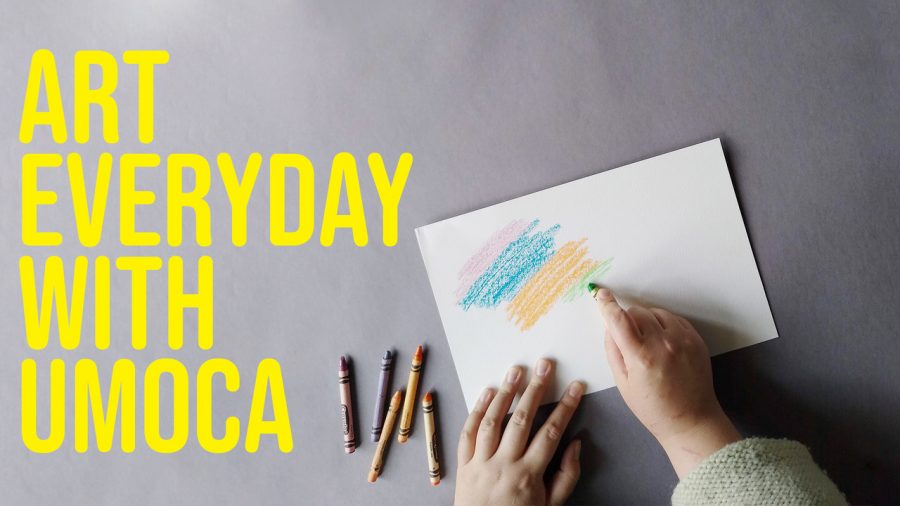Improvising Through a Pandemic — UMOCA’s Online Education
After closing its doors because of the COVID-19 pandemic, UMOCA’s new initiative aims to get kids creative while social distancing. (Courtesy Utah Museum of Contemporary Art)
April 16, 2020
During these anxious times through the pandemic and self-quarantine — with the situation worsening before it will begin to improve — many people are worried. Worried about the rising death toll, our struggling healthcare system, people who still gather and refuse to take this pandemic seriously or about the fact that many of our elected leaders are acting too slowly — too scared of hurting our economy to take essential life-saving actions. And of course, many are worried about how the economy will look once we do emerge from this disaster.
Every industry has been hit hard by the coronavirus and the arts and entertainment industries, in particular, are struggling — but we already know that. We already know Broadway has been shut up tight, performances have been canceled or postponed for the next month and museums have shut up shop. Workers throughout the industry are in a worrying spot right now, including emerging artists and performers as much as those on the front line — technicians, curators, stagehands, security and all those that make up the backbone of any show. It would be naive and unfair to overlook the struggles many are dealing with right now, but it’s important to realize not everything is dire right now. The arts industry is doing what it’s always done — pushing forward with the times and adapting. Our favorite talk shows are releasing episodes with skeleton crews and no audiences, musicians are performing from home with both ticketed and free live streams and even museums — like the Utah Museum of Contemporary Art — are bringing art to all the people stuck in isolation.
UMOCA Presents — Art Everyday
Since closing its doors on March 13, UMOCA has been improvising with new programs like “Art Everyday” to engage with the public in the virtual world. “Art Everyday” has been an addition to the museum’s Instagram with the goal to “provide children and families with creative art activities during self-isolation,” introducing a tutorial for a new art project each day. Over the past two weeks, this channel has covered all manner of easy, at-home crafts — from suncatchers and cave drawings to paper weaving. With these, families in isolation can keep children occupied for a few hours or spend the downtime together as if this were all just an extended summer art camp.
UMOCA’s tutorials come from their Education Staff and are made to be easily done at home. Still, they cover an impressive variety of artistic techniques that might inspire future artists. There are tutorials for abstract paintings made with string, homemade scratchboards, palette knife paintings improvised with a ruler, marbleized shaving cream designs and paper mosaics. Even a bored college student with a little creativity and too much time on their hands would enjoy themselves here.
Art Exhibits Move Online
The Art Truck, UMOCA’s traveling art space, has been grounded for the time being. However, the Truck’s current exhibit — “Work: An Audio-Visual Exploration of Effortful Lives” from Framework Arts — has been captured on camera and transformed into a 360-degree virtual tour. This piece is “a collective, participatory art project generated by the students and families of the west side neighborhoods of Salt Lake City.” It captures myriad voices and perspectives, especially among low-income and immigrant families, produced with students and families from Escalante Elementary School and KRCL Community Radio. It’s a powerful piece that looks provocatively at our understanding and assumptions about work, even lessened as it may be by the aesthetic distance of a computer screen.
At the risk of going unseen during this crisis, several of UMOCA’s other exhibits been brought into the virtual. Devin Harclerode‘s creation, “Boundaries,” can be virtually explored in the same manner as the Art Truck. Curtains created of camouflage cloth, hair, beads, fingernails and other textiles wall off a corner of the museum — her piece deals with social barriers and “the hope of transparency within a body politic.” On the UMOCA Instagram, Harclerode’s art is also showcased alongside her descriptions of the process and inspirations behind the piece.
Jane Christensen is another artist showing at the museum whose exhibit, “Mapping It Out,” has missed its chance at an audience and necessarily been brought online as well. Her playfully abstracted paintings and sculptures compose “a deep exploration of space — both of the material and the psychological, both science and illusion,” rooted in photographs of the Utah desert and her home of New York. Artists like Christensen and Harclerode might have lost the opportunity to bring their unique perspectives and voices to art lovers and the public at large without UMOCA’s efforts at making them available online.
During the next few weeks of struggling to remain sane, keep your mind active and creative and these resources handy. And, when the chaos surrounding coronavirus begins to ebb and things eventually return to normalcy, remember these organizations like UMOCA that are fighting to stay afloat and bring the arts to the public. UMOCA, in particular, relies on donations to continue its programs, but all of the arts will need a surge in patronage to get back on track after this disaster.









April • May 5, 2020 at 4:02 pm
Plandemic. Rest assured that this “pandemic” will be used to bring in complete totalitarian control. Grown adults in society obiedently standing 6ft away from each other in colored squares. Mechanically moving forward as the unit in front moves ahead in line. It is the duty of Americans to OBEY their government and the international organizations, WORSHIP science, and medical personnel are your GOD in the new medical tyranny of USA. Take the vaccine or otherwise you will be isolated unable to participate in society.